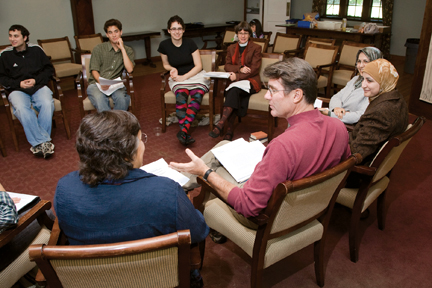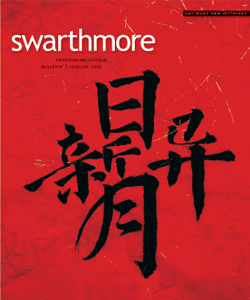Not Consensus but Friendship

The Rev. Joyce Tompkins (with the red neck scarf) values the existence of the SR group as a positive sign in a time when religion is seen so widely as a force for division and violence in the world.
This fall, in response to growing interest in interfaith text study, a new Scriptural Reasoning (SR) group became a permanent and regular fixture on campus, meeting at least three times each semester.
The practice of friendly dialogue about scriptural texts among Christians, Jews, and Muslims was first demonstrated at the College during A Week of Religion on Campus in February 2007 (see June 2007 Bulletin), when members of the campus community filled Kohlberg Hall’s Scheuer Room to hear three faculty members discuss renderings and interpretations of creation texts from the three traditions. The popular session led to subsequent occasional informal gatherings and a wish to form an official group.
In September, to help train the nascent group in the practice of SR, Arabic Language Instructor Yamine Mermer brought to campus Professor of Religious Studies Peter Ochs, a University of Virginia faculty member and leader in the SR movement under whom she had previously studied. Swarthmore faculty and staff members Mermer; the Rev. Joyce Tompkins, campus interfaith coordinator and Protestant adviser; Professor of Religion Mark Wallace; Part-time Visiting Instructor of Religion Rabbi Helen Plotkin ’77; Jewish Adviser Jake Rubin; Assistant Professor of Religion Tariq al-Jamil; Lecturer of Arabic Sawsan Abbadi; and Visiting Assistant Professor of Religion Elliot Ratzman as well as four students from each tradition assembled in Bond Hall for a seven-hour discussion that focused on Eve and the Garden of Eden.
“It was a long session because we were also being trained in SR, not just doing it,” Tompkins says.
Since then, the group, which plans to meet three times each semester, has discussed the story of Noah and the Flood and was anticipating a November session on Jonah and the Whale.
Wallace sums up the group as “a spirited gathering of students and scholars identified with the three Abrahamic religions of Judaism, Christianity, and Islam, who meet to discuss stories common to their three sacred texts—Bible, new testament, and Qur’an—in an open and nonsectarian setting. Our different scriptures exhibit parallel interests in key themes and personalities shared by all three traditions. What’s interesting to us is how the narratives are told and retold according to the different theological concerns.”
Since September, the group has grown to 22 members, and enthusiasm among participants is running high.
“It’s a very intimate activity, and the intimacy transforms people who were strangers—and texts that seemed strange—into friends,” Plotkin says.
Mermer agrees. “SR is about “not consensus but friendship,” she says. “Participants respect the differences between Judaism, Christianity, and Islam, and they don’t avoid disagreement as long it is friendly.”
Students from the three religious traditions perceive the sessions as a way of gaining further insight into their own traditions by learning more about the others.
“The perspectives of other faiths have led me to new and diverse interpretations of texts I have previously taken for granted, and these enrich my Christian beliefs,” says Anson Stewart ’10. Muslim student Ailya Vajid ’09 also values what she perceives as a unique opportunity to listen to the scriptural interpretations of members of other faiths. “Learning about the way someone from a different faith interprets a text from that faith sheds light both on that particular text and on the overarching themes present in each faith tradition.”
And Jewish student Jessa Deutsch ’10 is enjoying her first exposure to the Christian Bible and the Qur’an: “One of the really cool things about the discussions is that we really aren’t bound to the texts. We interpret them and act as if they were in conversation with each other, keeping in mind especially the chronological order of when they were ‘published.’”
Tompkins values the existence of the group as a positive sign in a time when religion is seen so widely as a force for division and violence in the world.
“This is such a clear example of Swarthmore at its best and religion at its best, and those are not two things that people often put in one sentence,” she says. “It’s a very happy union of the two.”
—Carol Brévart-Demm
 Email This Page
Email This Page